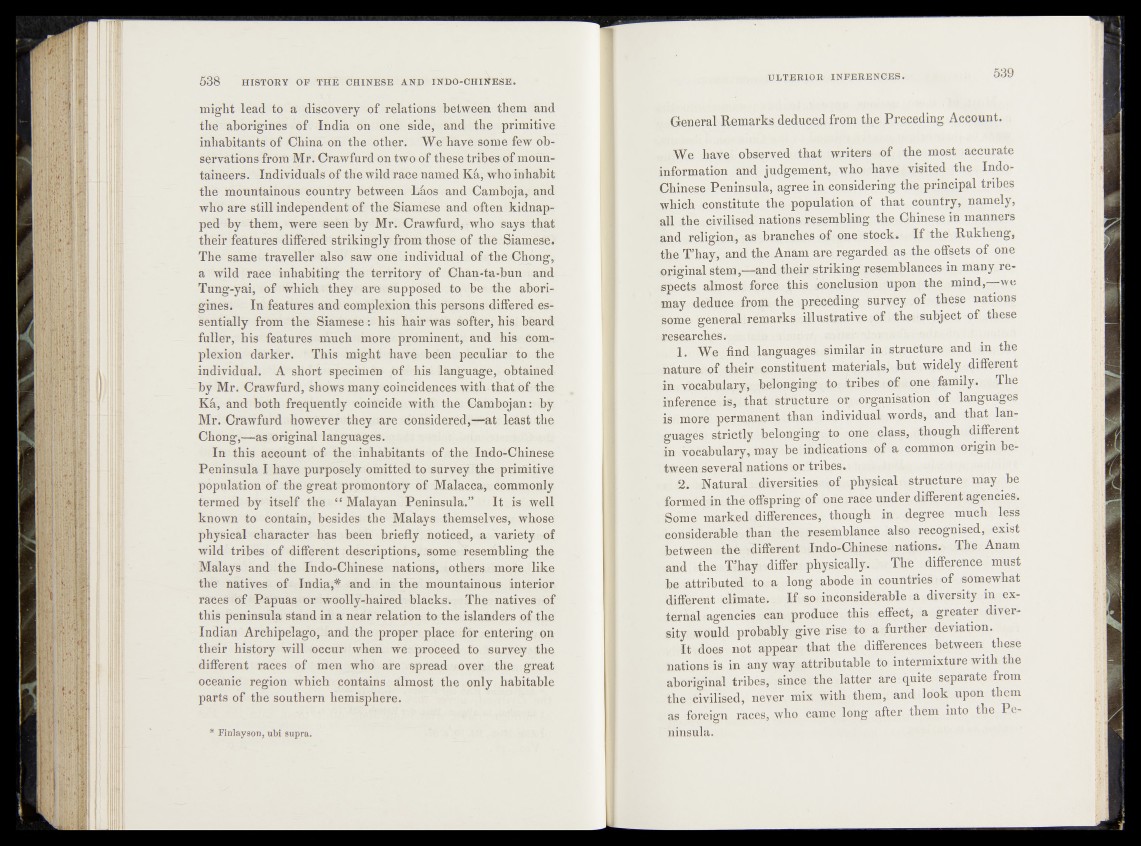
might lead to a discovery of relations between them and
the aborigines of India on one side, and the primitive
inhabitants of China on the other. We have some few observations
from Mr. Crawfurd on two of these tribes of mountaineers.
Individuals of the wild race named K4, who inhabit
the mountainous country between L4os and Camboja, and
who are still independent of the Siamese and often kidnapped
by them, were seen by Mr. Crawfurd, who says that
their features differed strikingly from those of the Siamese'.
The same traveller also saw one individual of the Chong,
a wild race inhabiting the territory of Ghan-ta-hun and
Tung-yai, of which they are supposed to be the aborigines.
In features and complexion this persons differed essentially
from the Siamese: his hair was softer, hisi beard
fuller, his features much more prominent, and his- complexion
darker. This might have be’en peculiar, to the
individual. A short specimen of his language, obtained;
by Mr. Crawfurd, shows many coincidences with-tbafcdf-the
Ka, and both frequently coincide with the Cambojan: by.
Mr. Crawfurd however they ;are considered,—at least the
Chong,—as original languages.
In this account of the inhabitants of the Indo-Chinese
Peninsula I have purposely omitted to survey the primitive
population of the great promontory of Malacca, commonly
termed by itself the “ Malayan Peninsula.” It J a well
known to contain, besides the Malays themselves, whose
physical character has been briefly noticed, a variety of
wild tribes of different descriptions, some resembling the
Malays and the Indo-Chinese nations, mothers more like
the natives- of India,f and in the mountainous interior
races of Papuas or woolly-haired: blacks* The natives of
this peninsula stand in a near relation to the islanders of the
Indian Archipelago, and the proper place for entering on
their history will occur when we proceed to survey the
different races of men who are spread .over the great
oceanic region which contains almost the only habitable
parts of the southern hemisphere.
* Finlayson, Tibi supra.
General Remarks deduced from the Preceding Account.
. tWe have observed that writers of the most accurate
information and judgement, who have visited the Indochinese
Peninsula, agree in considering the principal tribes
which constitute the population of that country, namely,
all the civilised nations resembling the Chinese iii manners
and religion, as branches of one stock. If the Rukheng,
the Thay, and the Anam are, regarded as the offsets of one
original stem,—and their striking resemblances in many respects
almost fprco this .conclusion upon the mind,—we
may deduce from the preceding survey of these nations
some general ; remarks illustrative of the subject of these
researches. ^
1. We find languages,; similar dp structure and in the
nature of their constituent materials; but widely different
.in, vocabulary^ belonging to tribes .of .; one family. The
inference is, that; structure orr organisation of languages
is; more permanent than individual words, and that languages
strictly belonging to one class, though different
in vocabulary, may be indications of a common origin her
tween seycral nations or tribes.
j 2. Natural diversities of physical structure may be
formed in the offspring; of one race under different agencies.
Some marked differences, though id. degree much less
considerable than the resemblance also recognised, exist
between the different Indo-Chinese nations. The Anam
and the* T’hay differ, physically..: The .difference must
be attributed to . a long abode sin countries * of -somewhat
different climate. If so inconsiderable a diversity in. external
agencies can produce this- effect, a greater diversity
would probably; give.rise to a further deviation.
It does not appear that the differences between these
nations is in any way attributable tOiln.termi2£lure will*- the
aboriginal tribes, since the latter are quite separate from
the civilised, never mix with them, and look upon them
as foreign races, who came long after them into the Peninsula.